
Over the many years since I came up with “Black Magic,” (pp. 89-92), I have found it extremely useful in many contexts. Here is how I apply it to Pseudo-psychometry.
People are always fascinated by the ancient mathematical curiosity known as magic squares–if they are presented quickly and smoothly. Intelligent audiences are particularly impressed by the rapid construction of one of these number squares that adds in all directions to a total freely stipulated by a spectator. In all the methods I have found in my extensive library, the number is revealed prior to the construction of the square. Imagine the impact this experiment could have if the spectator only thinks of the number!
I have had my business cards specially printed in five versions, each with a different house number.(1)
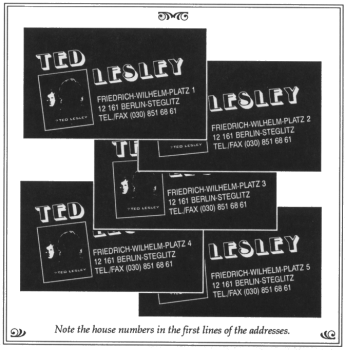 |
I arrange these cards in sets of five, each set having house numbers running from one through five in ascending order. The first four cards in the set each have a large white rectangular label on the back Card Five carries a similar but smaller label in the lower left corner. I have divided this label with a vertical line into two squares. The fifth spectator is asked to write the two digits of a number between thirty-four and one hundred in these squares. This is the number I will use to construct the magic square. But how do I learn this number? |
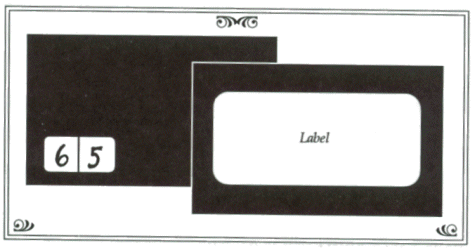
I demonstrate to the spectators how they are to put their cards into envelopes, and I use the fifth spectator’s card (the one with the number on it) for this demonstration.
You know the “Super Punx Test” don’t you?
In the last chapter of Punx’s Fourth Dimensional Mysteries(2) the reader will find Punx’s extraordinary “Super Punx Test” It is based on a wonderful secret, first published by Irv Weiner(3). However, Punx’s refinements make the principle more practical and take it into new realms of possibility. I would like to thank Meister Punx for allowing me to describe his diabolically clever idea to my readers.
After a long and intensive search, Punx found a special eyebrow pencil that had a specific and very useful characteristic: When you wrote on a piece of cardboard or paper, you were able to take an imprint of the writing with your moistened thumb and transfer it onto another piece of paper. The thumb became an impromptu stamp! This pencil was produced by a company in Berlin, but since Punx first discovered it, the composition of the pencil has been changed and no longer serves the purpose we require of it. (A few years back I bought hundreds of these pencils for Punx, only later discovering that they no longer worked. But all was not lost: Ludwig’s wife, Dagmar, is now equipped with eyebrow pencils until the year 2350!)
Again Punx searched and experimented until he found a substitute for the lost pencil. He found what he needed in the Stabilo Pencil No. 8046, though with this pencil one has to write with a thick point to get a good imprint. In the United States one can use the felt-tip pens by the Flair company that contain a water-soluble ink, although this ink will smudge when the impression is taken. Soft lead pencils will also work. I recommend that the reader also experiment with various eyebrow and grease pencils. You are bound to find certain ones with the attribute needed to make clear transferable impressions.
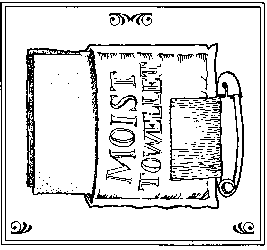 To avoid openly licking his thumbtip during performance, or coughing to conceal this action, both of which can be perceived as inelegant, Punx came up with another idea: Drugstores and cosmetic counters carry small damp napkins for the hands and face, which are individually sealed in convenient packets. Prepare one of these by tearing off an end of the packet. Next use a piece of adhesive tape to attach a safety pin to intact end of the packet. Pin this “thumb moistener” under your lapel and, just prior to performance, pull the folded napkin partially out of the packet. To avoid openly licking his thumbtip during performance, or coughing to conceal this action, both of which can be perceived as inelegant, Punx came up with another idea: Drugstores and cosmetic counters carry small damp napkins for the hands and face, which are individually sealed in convenient packets. Prepare one of these by tearing off an end of the packet. Next use a piece of adhesive tape to attach a safety pin to intact end of the packet. Pin this “thumb moistener” under your lapel and, just prior to performance, pull the folded napkin partially out of the packet.
You now have only to touch the napkin casually under the lapel and your thumb will be ready to take the imprint.
Please don’t skim over this principle, even if you know it. Try instead to imagine the possibilities! Punx has demonstrated some sensational uses, and the trick I’m now describing is only one of many applications.
In devising a new use for the principle, my main concern was to have a logical reason to require a spectator to write on a surface small enough to enable me to take an imprint of it with my thumb. My black business cards gave me that reason. They force the spectator to write on the white field of the label.
We now turn to the composition of the magic square:
If you create a magic square on a blackboard or large sketch pad, it always has an impact on the audience. Unfortunately, many mentalists avoid the effect, thinking it far too complicated. Composing a magic square with a number given by a member of the audience looks like a miracle to any reasonably intelligent spectator. Can you imagine the impact of this experiment when the volunteer only thinks of the number!
The following version, created by Royal V. Heath,(4) is not at all difficult to learn. It is possible to construct squares totaling from twenty-three to ninety-nine without resorting to negative numbers, but totals from twenty-three to thirty-three necessitate the use of duplicate numbers in the square, making it slightly less impressive.
The illustration on the next page shows cells that always contain the same numbers. They never change:
You must remember the positions A, B, C and D. Later, you enter calculated numbers into these fields.
Let’s say the spectator thinks of the number sixty-five. To complete the square, a little calculation is necessary. Regardless of which number is selected, you always subtract twenty-one from it. In our example that would mean: 65 – 21 = 44.
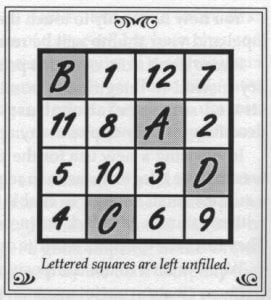 |
This number is entered into Cell A (second row, third column). This basic number is increased by one and the result (45) is entered in Cell B (top left). Add one again and enter this result (46) in Cell C (fourth row, second column). Finally, add one once more and enter the result (47) in Cell D (third row, fourth column).
|
The completed square will look like this:
|
To facilitate the quick filling of the square in front of an audience, you can use a sketch pad with an empty magic square drawn on it and the constant numbers secretly filled in with a white crayon. The white writing is visible to you, but invisible to the audience from just a short distance. Light pencil can also be used.
|
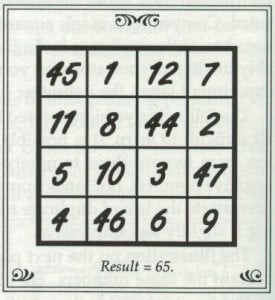 |
If you are feeling bold, have the pad writing side down on your table, with the constant numbers already filled in by marker. When you are ready to construct the square, take up the pad and hold it between your abdomen and one hand while with the other hand you enter the missing numbers. But don’t forget to act as though you are filling in all the numbers (scratch on the pad with your fingertip). To the spectators it appears as if you completed the magic square in seconds! If you take this course, you can use an erasable marker and suitably laminated board.
In recent years I have modified a very clever idea of Roy Johnson’s (5) for this demonstration:
To a standard clipboard, attach a large piece of cardstock on which you have boldly drawn or printed the cells for your magic square. The card should be bright yellow, for maximum visibility, and just a bit smaller than the clipboard itself. Use a few dabs of non-permanent dry-mount fixative, rubber cement or some similar product that allows you to fix the card to the clipboard, yet remove it and attach a fresh one after each performance. Fill in the constant numbers on this square, leaving the four key cells blank.
Clip a duplicate yellow card over the first. This card bears an identical magic square, but all the cells are empty. Align this second card perfectly over the first to conceal it. In performance you display the empty magic square on the clipboard and, as you handle it, you press the clip, letting the top card slip down and free of it. Lay the clipboard, with the (loose) card, face down on your table while you pick up a stopwatch and hand it to an audience member. Show him how to operate the watch, then return to the stage and pick up the clipboard, leaving the card behind on the table. Of course, you must now keep the partially filled magic square on the board concealed from the audience.
Have the spectator who thought of a number concentrate on it as you try to receive her thoughts. After a few moments of mutual meditation, during which you can make the necessary mental calculations, you pick up a felt-tip marker and ask the person with the stopwatch to time you as you fill in the square. Fill in the four empty cells and pretend to fill in the others; then call out, ‘Stop!” to the timekeeper. Reveal the completed magic square and ask for the time elapsed while you filled it in. From this dramatic foundation you can now build to a truly stunning climax as you ask the spectator to announce the number she was thinking of, then show that the square adds to that number in all directions!
For those not familiar with Heath’s magic square, I should point out that not only do all the rows and columns add to the correct number, but so do the diagonals, the four numbers in the comer cells and every square of four numbers as well!
Having explained the coding of the cards, Punx’s secret and the working of the instant magic square, the balance of the method is quickly told. Having stolen the imprint of the number from the card as you show the spectators how they are to insert their cards into the envelopes, you have someone mix the five envelopes and return them to you. You are able to identify the envelope containing the number as you have had the foresight to trim its flap slightly but (to you) noticeably shorter. Pick up one of the other envelopes, tear it open and remove the card inside. In doing so, leave an imprint from your thumb on the torn-off end piece and secretly note the number as you tuck the piece safely away in your pocket.
Now note the code number on the front of the card and begin your psychometric reading. Continue to “read” three more cards, leaving the number card for last. Hand this envelope back to its owner and ask him to concentrate on his number. Then proceed with the construction of the magic square, building to a powerful climax that produces the mentally selected number in a most extraordinary manner!
———–
(1) This coding idea first surfaced years ago, applied to the zip code in the address. The idea seems to have been independently conceived by several magicians, including Joseph White, David Ward, David Robbins and Larry Becker. I have been using the subtler positioning of the code number as a house number for years. Recently I discovered that James Randi has had the same idea. See Waters’ Mind, Myth & Magick, p. 142.
(2) Pp. 211-231.
(3) See his 1948 manuscript, Impromptu Impression. Five years later Milbourne Christopher would claim independent discovery of the same transfer principle in his book Varied Deceptions, pp. 9-12. This principle, though applied in an entirely different manner, was probably first employed in the old “Potsherd Trick”, commonly known in the Western world as “The Sugar Cube Trick”.
(4) Hilliard’s Greater Magic, pp. 923-924.
(5) “Flash Square” on his Roy Johnson: The Voice of Experience, Volume One audio tape (1977).
|
